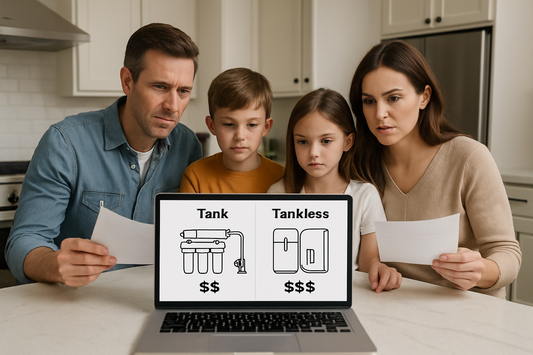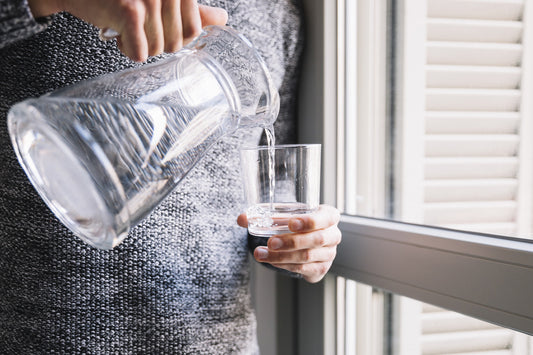Is Your Water Really Safe? TDS Testing Reveals the Truth
Last Tuesday, Sarah from Portland thought her tap water was perfectly fine. It looked crystal clear, had no unusual smell, and came from a trusted municipal source. But when she tested it with a simple TDS meter, the numbers told a different story—her water contained 350 parts per million of dissolved solids, nearly double what health experts recommend for optimal drinking water.
Sarah's story isn't unique. Across America, millions of families are unknowingly consuming water with concerning levels of dissolved contaminants. The question isn't whether your water looks clean—it's whether you truly know what's in it. That's where home water quality testing becomes your family's first line of defense.
The Hidden Reality of "Clean" Water
Your tap water travels through miles of aging infrastructure before reaching your glass. Along the way, it collects minerals, metals, and other dissolved substances that form what scientists call Total Dissolved Solids (TDS). While some minerals are beneficial, others can pose serious health risks when present in high concentrations.

What TDS really means for your health:
- 0-50 ppm: Excellent water quality, but may lack essential minerals
- 50-150 ppm: Good quality with beneficial minerals
- 150-300 ppm: Fair quality, monitor for specific contaminants
- 300+ ppm: Poor quality, immediate testing recommended
The Environmental Protection Agency considers water with TDS levels above 500 ppm unfit for drinking, yet many American homes unknowingly exceed 300 ppm daily. This is why learning how to test water quality at home has become essential for protecting your family's health.
Why Traditional Water Appearance Tests Fail
Most people rely on their senses to judge water quality—if it looks clear and tastes normal, it must be safe, right? Unfortunately, this approach misses the most dangerous contaminants. Lead, arsenic, nitrates, and other harmful substances are often completely invisible and tasteless at dangerous levels.
Consider these sobering statistics:
- Over 21 million Americans receive water from systems with health violations
- Lead contamination affects water systems serving 12 million people
- Agricultural runoff introduces nitrates into drinking water for millions more
These contaminants don't announce themselves with bad taste or cloudy appearance. They silently accumulate in your body over time, potentially causing serious health issues including cardiovascular problems, developmental delays in children, and increased cancer risk.
The Science Behind TDS Measurement
A TDS measurement meter works by measuring the electrical conductivity of your water. Pure water doesn't conduct electricity well, but dissolved minerals and contaminants create conductivity. The meter converts this electrical reading into parts per million (ppm), giving you a clear picture of your water's purity level.
Modern TDS meters offer several advantages:
- Instant results: No waiting for lab reports
- Cost-effective: One-time purchase for ongoing monitoring
- Easy to use: Simple digital displays anyone can read
- Portable: Test water anywhere, anytime
Step-by-Step Guide: How to Test Your Water at Home
Before you begin: Ensure your TDS meter is clean and calibrated. Most quality meters come pre-calibrated, but monthly calibration with standard solutions ensures accuracy.
Testing process:
- Fill a clean glass with water from your tap
- Remove the meter's cap and rinse the probe with distilled water
- Immerse the probe about 2 inches into your water sample
- Wait 10-15 seconds for the reading to stabilize
- Record the TDS level displayed on the screen
- Clean the probe with distilled water after use
Pro tip: Test water at room temperature for most accurate results. Hot water can damage sensitive probes and skew readings.
Interpreting Your Results: What the Numbers Mean
Once you have your TDS reading, understanding what it means for your family's health is crucial. Here's how to interpret your results:
Low TDS (0-150 ppm): Generally safe but may indicate over-filtration. Very low TDS water lacks beneficial minerals like calcium and magnesium that support bone health and cardiovascular function.
Moderate TDS (150-300 ppm): Typically acceptable for drinking, but consider testing for specific contaminants. This range often indicates good mineral content with manageable dissolved solids.
High TDS (300+ ppm): Immediate action recommended. While not always dangerous, high TDS often correlates with elevated levels of potentially harmful substances requiring professional water analysis.

Common Household Water Problems Revealed by TDS Testing
Hard water issues: High TDS readings often indicate excessive calcium and magnesium, leading to scale buildup in pipes and appliances. This costs the average American household over $800 annually in appliance damage and energy inefficiency.
Agricultural contamination: Homes near farming areas frequently show elevated TDS from fertilizer runoff, potentially including harmful nitrates that pose special risks to pregnant women and infants.
Aging infrastructure: Older homes with original plumbing may show high TDS from corroded pipes leaching metals into drinking water. Lead and copper contamination often go undetected without proper testing.
Beyond TDS: When to Seek Professional Testing
While at home water quality testing with TDS meters provides valuable baseline information, certain situations require professional laboratory analysis:
- TDS levels consistently above 300 ppm
- Sudden changes in TDS readings
- Proximity to industrial areas or known contamination sources
- Pregnant women or households with young children
- Well water sources (private wells aren't regulated like municipal systems)
Professional testing identifies specific contaminants that TDS meters cannot differentiate. This detailed analysis guides targeted treatment solutions rather than guessing at filtration needs.
Protecting Your Family: Next Steps After Testing
Discovering concerning TDS levels doesn't mean panic—it means taking informed action. Based on your results, consider these solutions:
For moderate TDS elevation (200-400 ppm): A quality whole house water filtration system can effectively reduce dissolved solids while preserving beneficial minerals. These systems provide comprehensive protection for drinking, cooking, and bathing.
For high TDS readings (400+ ppm): More aggressive filtration may be necessary. Reverse osmosis systems excel at removing dissolved solids but require careful consideration of mineral replacement to avoid over-purification.
For specific contaminant concerns: Targeted filters address particular issues like lead, chlorine, or nitrates based on professional water analysis results.
The Long-Term Benefits of Regular Water Testing
Families who regularly monitor their water quality with TDS meters report several benefits:
Health confidence: Knowing your water quality provides peace of mind, especially for parents concerned about children's development and long-term health.
Cost savings: Early detection of water quality issues prevents expensive appliance damage and reduces bottled water dependence.
Environmental impact: Home filtration systems reduce plastic waste from bottled water while ensuring consistently safe drinking water.
Property value: Homes with documented water quality monitoring and appropriate filtration systems often command higher resale values.
Making Water Testing Part of Your Routine
Like checking smoke detector batteries or changing air filters, regular water testing should become part of your home maintenance routine. Test your water monthly, especially if you notice:
- Changes in taste or odor
- Seasonal variations (agricultural runoff varies by season)
- Nearby construction or industrial activity
- New regulations affecting your water supplier

Image by prostooleh
Your Family's Health Is Worth the Investment
The cost of a quality TDS meter—typically $15-50—represents one of the most cost-effective health investments you can make. Compare this to the potential costs of waterborne illness, appliance damage, or long-term health issues from contaminated water exposure.
Remember Sarah from our opening story? After discovering her high TDS levels, she installed a whole house filtration system. Six months later, her TDS readings dropped to 120 ppm, her appliances run more efficiently, and most importantly, she has confidence in her family's water safety.
Your water quality directly impacts your family's health every single day. Don't wait for obvious problems to emerge—they often don't until serious damage is done. Start with simple TDS testing today, and take the first step toward ensuring the water your family drinks, cooks with, and bathes in meets the highest safety standards.
The question isn't whether you can afford to test your water—it's whether you can afford not to know what's in it.





